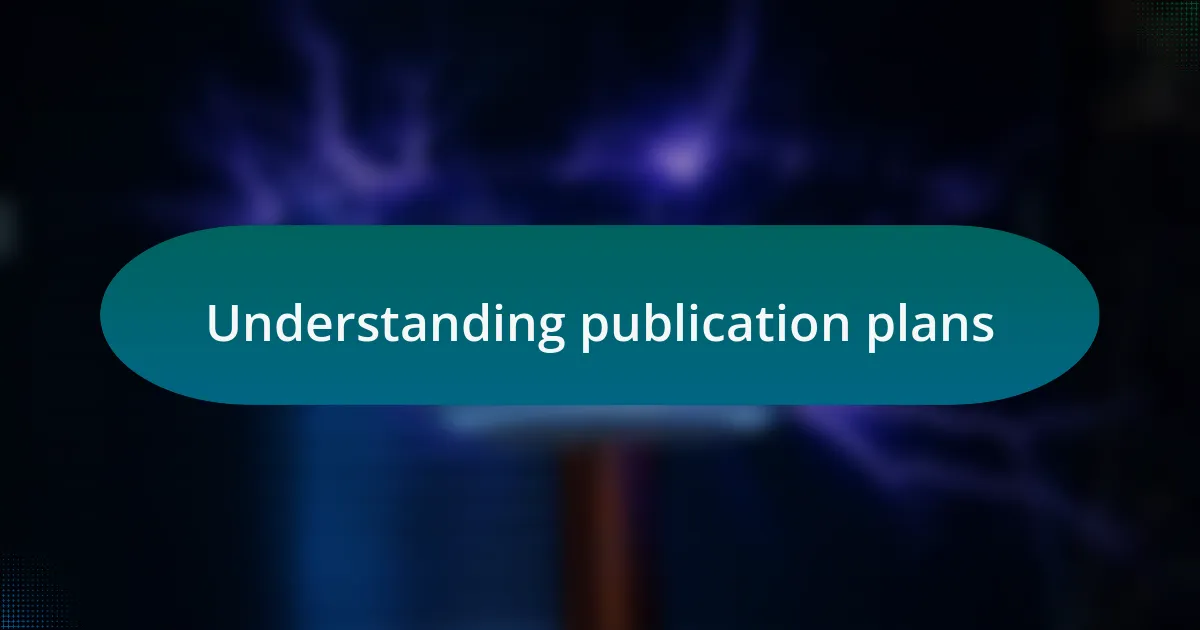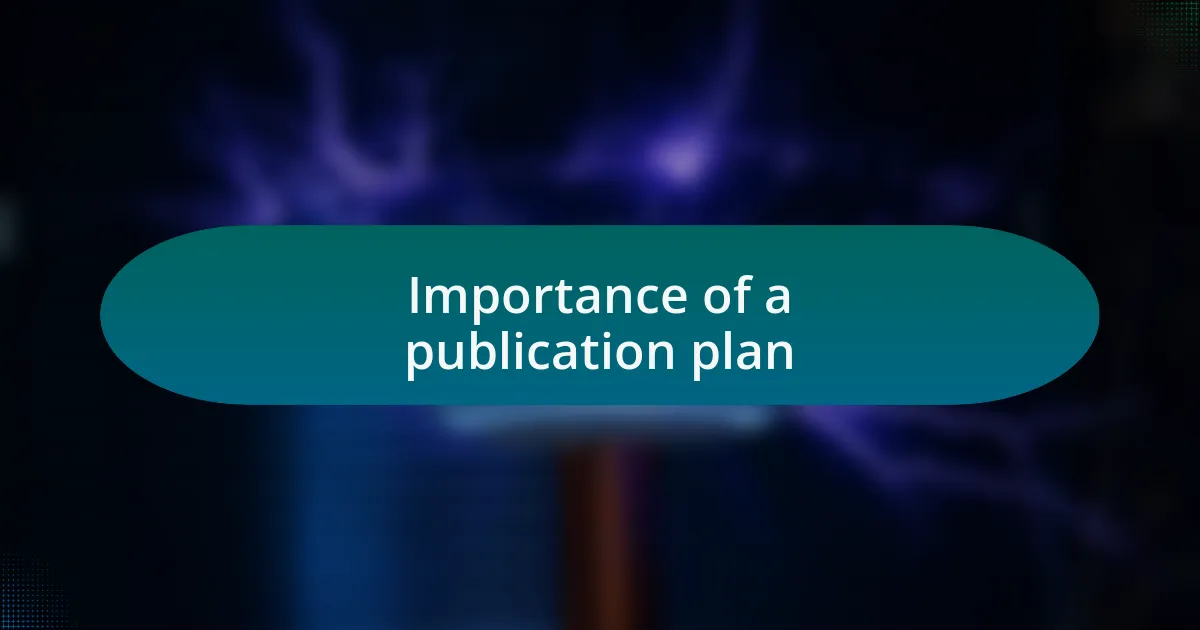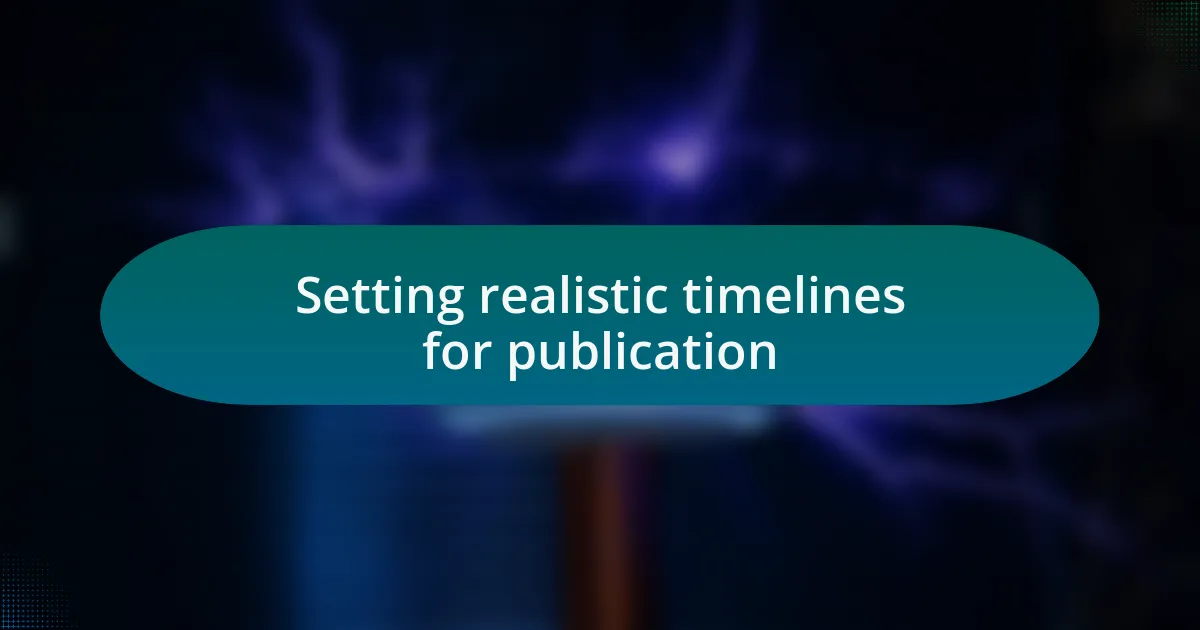Key takeaways:
- A publication plan acts as a flexible roadmap that helps strategize goals, target audiences, and suitable journals to enhance research visibility.
- Setting realistic timelines and breaking down the publication process into manageable steps can alleviate stress and maintain momentum.
- Regular evaluation and adjustment of the publication plan, including feedback from peers, helps to mitigate burnout and reignite enthusiasm for the research.

Understanding publication plans
When I first delved into creating a publication plan, I realized it’s more than just a timeline; it’s a roadmap to disseminate your research effectively. Have you ever been overwhelmed with numerous journals and submission deadlines? That was me, too. A well-articulated plan helps eliminate the chaos by laying out clear goals, target audiences, and preferred venues for sharing your findings.
One of the insights that struck me was the importance of being realistic about the publication timeline. I once set ambitious deadlines that led to unnecessary stress when they weren’t met. Now, I recommend thinking of your plan as a flexible framework rather than a strict schedule. This way, you adapt as needed without losing sight of your objectives.
In addition to goals and timelines, understanding the nuances of each publication venue is crucial. I’ve learned that different journals have distinct priorities and readerships. Wouldn’t it be frustrating to submit to the wrong one after pouring your heart into your research? That’s why taking the time to analyze each potential publication can pay off immensely in terms of reaching the right audience and having your work recognized.

Importance of a publication plan
A publication plan is essential because it directs your research impact in a crowded field. I remember my early days when I scattered my manuscripts to various journals, only to discover I wasn’t targeting the right readership. It was disheartening to see my hard work go unnoticed. Having a clear plan allows me to strategically focus on venues that align with my research themes and can maximize visibility.
Moreover, a robust publication plan serves as a motivational tool. Once, when I felt disheartened by the slow publication processes, I revisited my plan and realized how it kept me accountable. It provided those little milestones I could celebrate along the way, reminding me of progress, even during the waiting periods. Have you experienced that same sense of accomplishment when ticking off tasks? It’s motivating!
Lastly, clarity is key in navigating collaborations and co-authorships. I recall a project where miscommunication almost derailed our efforts, simply because we lacked a shared publication plan. By establishing clear roles and responsibilities in advance, we not only avoided confusion but also enhanced our teamwork. Isn’t it comforting to know that a well-prepared plan can strengthen partnerships and lead to a more successful publication experience?

Setting realistic timelines for publication
Setting realistic timelines for publication is crucial for managing expectations and maintaining momentum. In my experience, projects tend to take longer than anticipated, often due to unexpected revisions or feedback loops. I once planned to submit a manuscript within three months but found myself needing an additional two months for revisions and peer reviews. Have you ever under-anticipated the time necessary for thorough feedback? It’s easy to do, but setting more realistic timelines can save you from added stress.
I’ve learned that breaking down the publication process into smaller, manageable steps makes it easier to establish a timeline. For instance, I typically allocate specific time frames for drafting, reviewing, and revising, which helps me stay on track. When I tackle each stage with a clear deadline in mind, it breaks the overwhelming project into bite-sized tasks, making the process feel more achievable. This approach not only keeps my anxiety in check but also ensures that I nurture the quality of my work.
Additionally, I recommend regularly revisiting and adjusting timelines as needed. I vividly recall a project where I faced unexpected delays due to collaborators’ schedules and needed to recalibrate my expectations. This taught me the importance of flexibility. Have you ever had to adjust your timelines? Embracing adaptability can lead to a more positive and productive publication journey, making the process less daunting and more enjoyable.

Evaluating and adjusting your plan
Evaluating and adjusting your publication plan is a continuous process that requires keen observation and honest reflection. I remember a time when I was so focused on meeting my original goals that I ignored signs of burnout creeping in. It was only after a colleague pointed out my dwindling enthusiasm that I realized the importance of stepping back to assess not just my timeline, but my overall approach. Have you ever found yourself pushing through fatigue, ignoring the need for a break? Those moments often signal that a reevaluation might be in order.
As you gauge your progress, it’s essential to gather feedback from peers or mentors. I once incorporated a simple midpoint review into my plan, asking trusted colleagues to assess my work’s direction. Their insights were invaluable, revealing perspectives I hadn’t considered and leading to crucial adjustments in both content and timeline. Engaging others can provide a fresh lens through which to view your project, often sparking ideas you might not have entertained on your own.
Regular check-ins are not just about assessing timelines; they’re also an opportunity to reconnect with your passion for the project. I’ve found that taking the time to reflect on what excites me about my research can reinvigorate my commitment. What drives you? By addressing this question during evaluations, I’ve often rediscovered the motivation that fuels my publication efforts, ensuring I stay aligned with both my objectives and my enthusiasm.